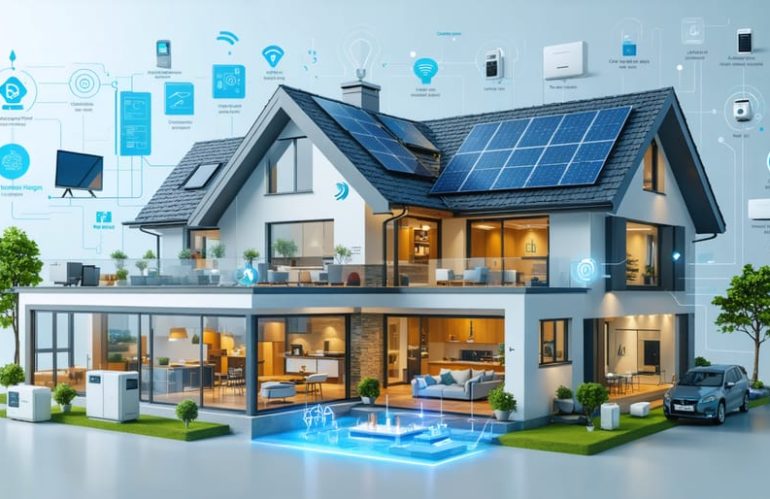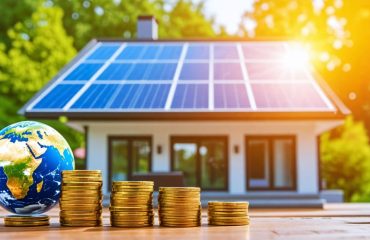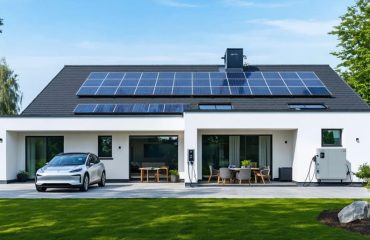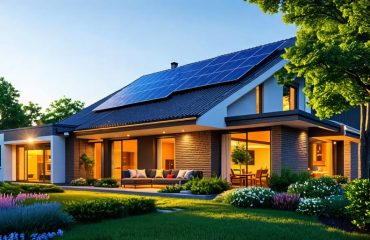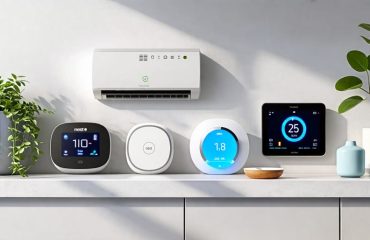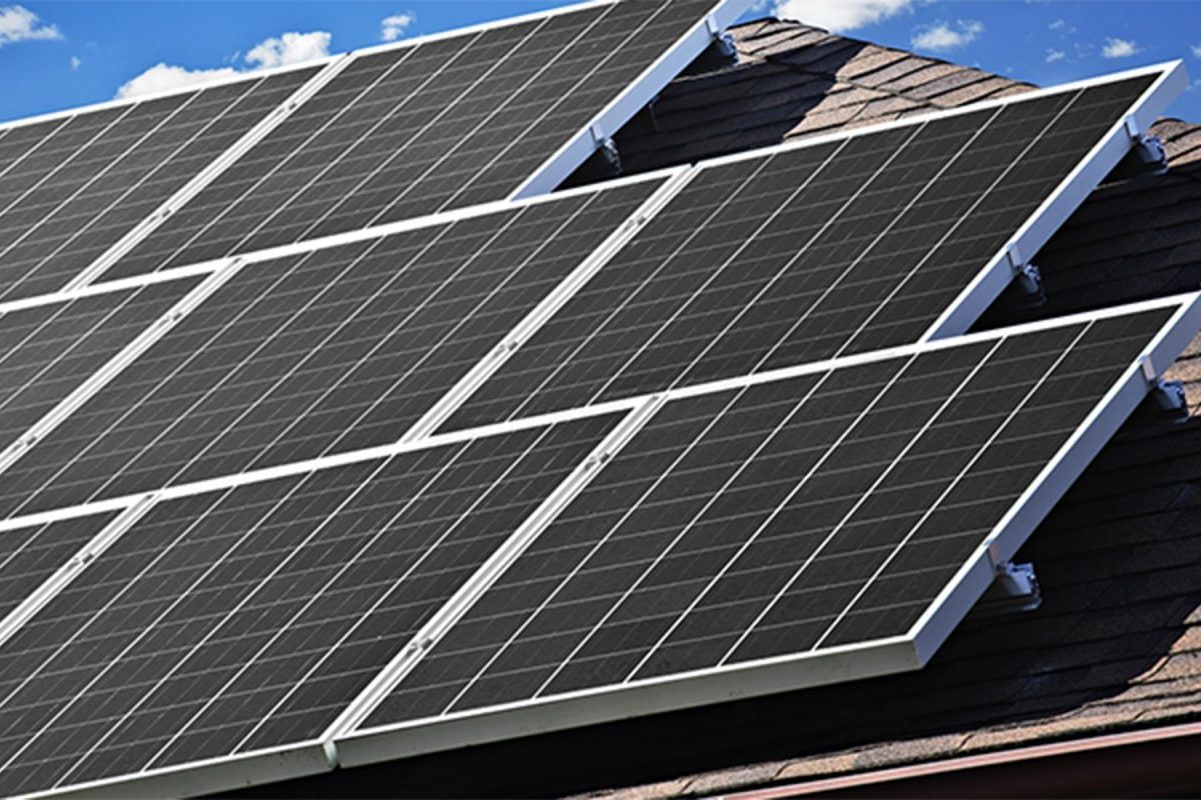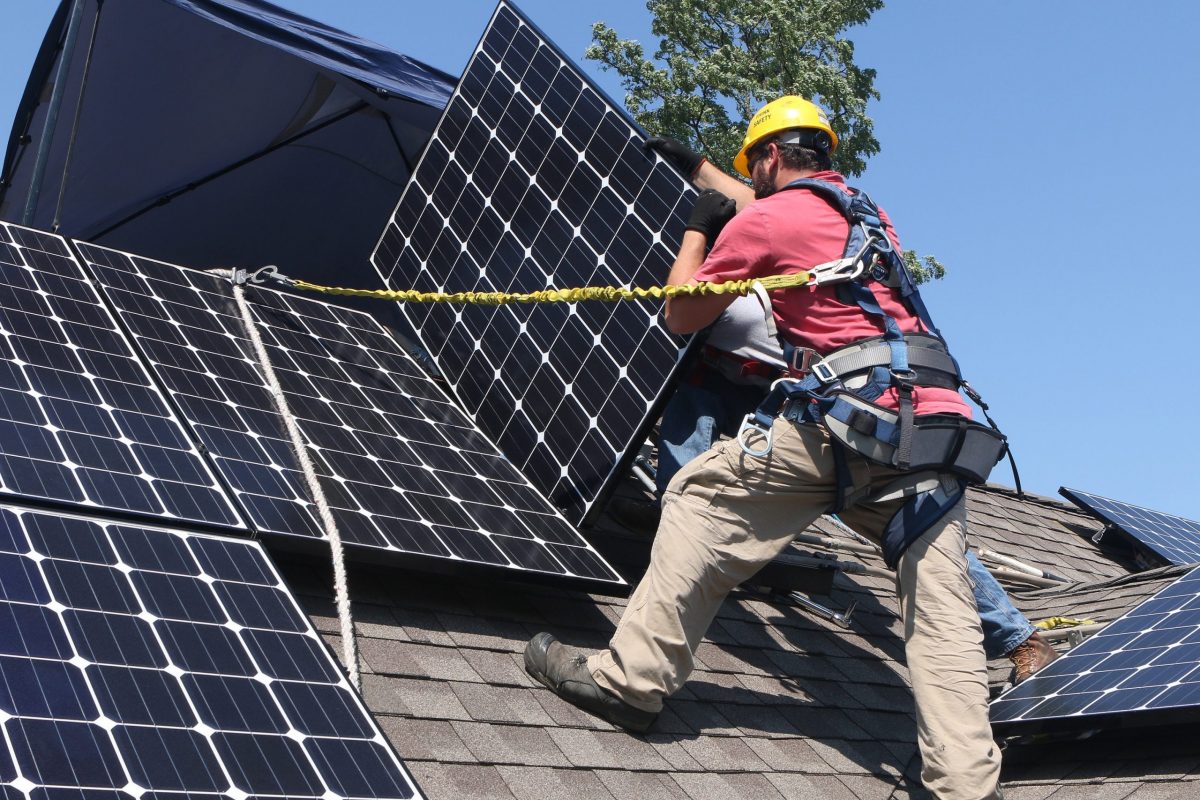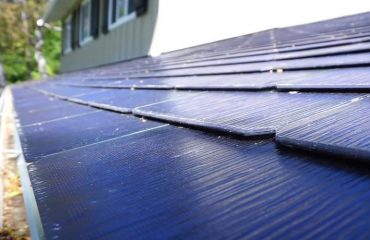Transform your home into an energy-efficient powerhouse by integrating residential solar systems with smart home automation. Connect solar production data to your home’s smart hub, enabling automatic adjustment of major appliances based on peak solar generation times. Program smart thermostats to pre-cool or pre-heat your home when solar output is highest, maximizing free energy usage while maintaining comfort. Schedule battery storage systems to charge during optimal daylight hours and discharge during expensive peak utility rates.
Modern home automation bridges the gap between sustainable energy generation and intelligent consumption, creating a seamless ecosystem that optimizes power usage without sacrificing convenience. By synchronizing your home’s energy demands with solar production patterns, automation delivers average energy savings of 20-30% while reducing grid dependence. Smart integration transforms passive solar panels into active participants in your home’s energy management strategy, automatically adapting to weather patterns, utility rates, and household routines.
Why Integrate Home Automation with Solar?
Maximizing Energy Efficiency
Home automation can significantly boost your solar power system’s efficiency by intelligently managing energy consumption and production. Smart home systems can automatically adjust your appliance usage based on peak solar production hours, ensuring you maximize the free energy from your panels. For example, your automated system can schedule energy-intensive tasks like running the dishwasher or charging electric vehicles when solar generation is at its highest.
Modern automation systems also provide real-time monitoring of your energy production and consumption patterns. This data helps you make informed decisions about your energy usage and identify opportunities for further optimization. Smart thermostats can automatically adjust your home’s temperature based on solar availability, while automated blinds can help manage natural heat gain and reduce cooling needs.
Battery storage systems become even more effective when integrated with home automation. Your system can intelligently decide when to store excess solar power and when to use it, based on factors like weather forecasts, electricity rates, and your typical usage patterns. This smart management ensures you’re making the most of your solar investment while minimizing reliance on grid power during peak rate periods.
Real-Time Energy Management
Real-time energy management transforms your home into a smart, efficient ecosystem that automatically responds to your energy needs. Through advanced sensors and smart algorithms, your home automation system continuously monitors energy consumption patterns and adjusts accordingly. When solar production peaks during sunny hours, the system can automatically run energy-intensive appliances like washing machines or dishwashers to maximize solar power usage.
The system also learns from your daily routines, automatically adjusting thermostat settings, lighting levels, and appliance operations to optimize energy efficiency. For example, it can dim lights in unused rooms, adjust HVAC settings based on occupancy, and even control smart blinds to help with temperature regulation.
These automated adjustments typically result in 15-30% energy savings for homeowners. The real-time monitoring feature provides instant feedback through smartphone apps, allowing you to track energy usage and production patterns. This visibility helps you make informed decisions about your energy consumption while the automation handles the day-to-day optimizations.
The system can also integrate with weather forecasts to prepare for upcoming weather changes, ensuring your home maintains optimal comfort while maximizing energy efficiency.
Essential Components for Solar-Automation Integration
Smart Inverters and Monitoring Systems
Smart inverters and automated monitoring systems form the backbone of modern solar installations, working together to maximize your energy production and consumption. These intelligent components transform your solar setup from a simple power generator into an integrated part of your home’s ecosystem.
At the heart of this integration are solar energy management systems that continuously monitor your power generation, usage patterns, and grid interaction. These systems automatically adjust power flow based on your home’s needs, ensuring optimal energy distribution throughout the day.
Modern smart inverters can communicate with your home automation hub, allowing you to create custom routines that maximize solar usage. For example, they can automatically start energy-intensive appliances during peak solar production hours or store excess energy in batteries for later use. This intelligent coordination helps reduce reliance on grid power and lowers utility bills.
The monitoring aspect provides real-time insights through user-friendly apps, letting you track performance, identify potential issues, and make informed decisions about your energy usage. Many systems even offer predictive maintenance alerts and automated troubleshooting, ensuring your solar investment operates at peak efficiency with minimal intervention.
By integrating these smart components with your existing home automation setup, you create a seamless ecosystem that optimizes energy usage while maintaining comfort and convenience. The system works quietly in the background, making sustainable living effortless and rewarding.
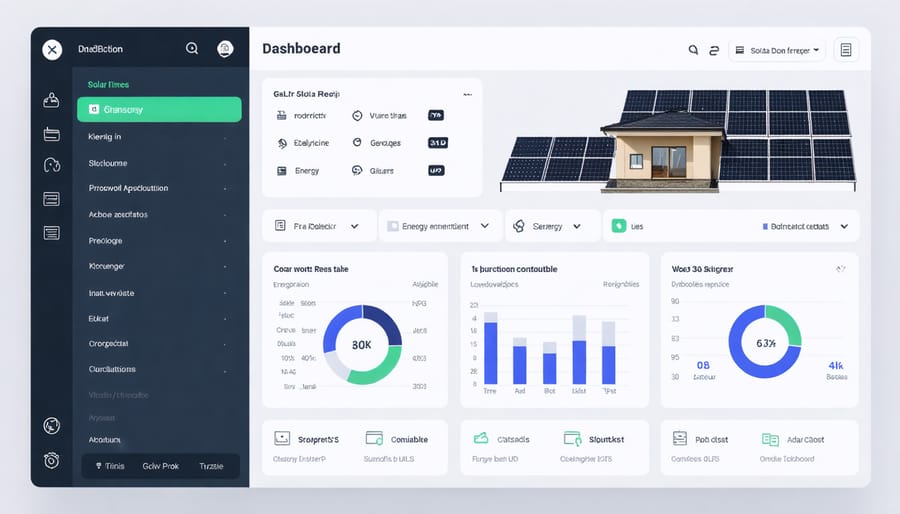
Compatible Smart Home Devices
Modern solar systems work seamlessly with a variety of smart home devices to maximize energy efficiency and convenience. Smart thermostats like Nest and Ecobee can automatically adjust your home’s temperature based on solar production, optimizing energy usage during peak sunlight hours. These devices learn your preferences and can shift energy-intensive heating or cooling to times when your panels are generating the most power.
Smart plugs and outlets from brands like TP-Link and Wemo allow you to monitor and control the power consumption of individual appliances. You can schedule energy-hungry devices like dishwashers and washing machines to run during solar-productive hours, ensuring you’re using clean energy directly from your panels.
Smart lighting systems from Philips Hue and LIFX can be programmed to adjust brightness based on natural light availability and your solar production. Many also include motion sensors to prevent unnecessary energy usage when rooms are unoccupied.
Battery storage systems like the Tesla Powerwall and LG Chem RESU integrate particularly well with home automation systems. These can be programmed to store excess solar energy during peak production and release it during high-demand periods or grid outages.
Energy monitoring systems from companies like Sense and Emporia provide real-time data about your energy consumption and solar production, helping you make informed decisions about when to run appliances for maximum efficiency.
Setting Up Your Automated Solar Home

Basic Setup and Configuration
Getting started with home automation integration is simpler than you might think. Begin by choosing a central hub that will serve as the brain of your system. Popular options include SmartThings, Home Assistant, or Apple HomeKit. These platforms act as command centers, allowing different smart devices to communicate with each other seamlessly.
Next, ensure your home has a stable Wi-Fi network, as this forms the foundation of most automated systems. Consider installing a mesh network if you have a larger home or areas with weak signal strength. It’s also wise to set up a dedicated network for your smart devices to enhance security and prevent interference with your regular internet usage.
Start small by connecting basic devices like smart plugs or lights. These are excellent entry points into home automation and help you become familiar with the system’s operation. Once comfortable, gradually add more sophisticated components such as smart thermostats, security cameras, or automated blinds.
Remember to create a backup power solution for critical systems. A small UPS (Uninterruptible Power Supply) can keep your hub and essential devices running during brief power outages. Additionally, take time to organize your devices into logical groups or “scenes” based on their location or function. This makes managing your automated home much more intuitive and user-friendly.
Creating Smart Energy Rules
Creating smart energy rules is like programming your home to be an efficient energy manager. By setting up automated responses, you can maximize your energy savings while maintaining comfort. Start by establishing basic schedules that align with your daily routine – for instance, programming your thermostat to adjust temperatures during work hours or setting your water heater to operate during off-peak periods.
Consider creating condition-based rules that respond to real-time factors. For example, you can program your system to automatically close motorized blinds when the sun is directly hitting your windows, reducing the need for air conditioning. Smart plugs can be scheduled to cut power to devices during non-use hours, eliminating phantom energy drain.
Weather-responsive automation adds another layer of intelligence. Set up rules that adjust your HVAC system based on outdoor temperature and humidity levels. You might program your irrigation system to skip watering when rain is forecasted, saving both water and the energy needed to pump it.
For optimal results, create seasonal rules that account for changing daylight hours and temperature patterns. Winter rules might prioritize heating during morning hours, while summer rules could focus on pre-cooling your home before peak afternoon temperatures.
Remember to review and adjust your rules periodically. Monitor your energy usage patterns through your smart home dashboard and fine-tune your automation strategies for maximum efficiency.
Mobile Apps and Remote Control
Modern home automation systems put complete control of your solar setup right at your fingertips through intuitive mobile apps and remote access capabilities. Whether you’re at work, on vacation, or simply relaxing on your couch, you can monitor and adjust your system’s performance using your smartphone or tablet.
These user-friendly apps provide real-time data about your energy production and consumption, allowing you to make informed decisions about power usage. You can check how much energy your panels are generating, view historical performance data, and even receive alerts if your system needs attention.
The remote control functionality enables you to adjust settings instantly. Turn on your dishwasher when solar production peaks, schedule your EV charging for optimal times, or adjust your smart thermostats to maximize energy efficiency. Many apps also feature automation rules that you can customize based on weather forecasts, time of day, or energy prices.
Security is a top priority in these mobile solutions, with encrypted connections and multi-factor authentication protecting your system from unauthorized access. Most platforms also offer automatic updates to ensure you always have the latest features and security improvements.
For additional convenience, many apps integrate with popular voice assistants like Alexa or Google Home, allowing you to control your solar-powered home through simple voice commands.
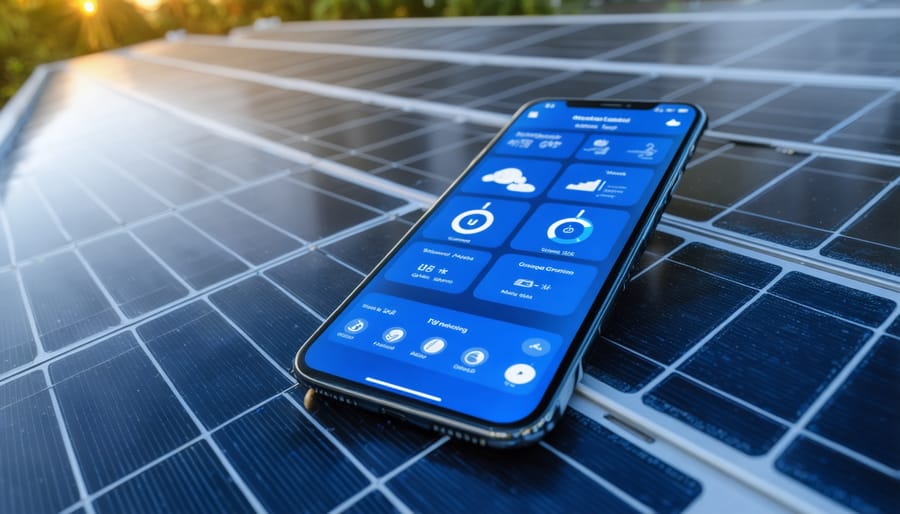
Practical Applications and Benefits
Automated Load Shifting
One of the most effective ways to maximize your solar investment is through automated load shifting, which strategically schedules your high-energy appliances to run during peak sunlight hours. This smart load management approach ensures you’re using solar power when it’s most abundant, typically between 10 AM and 4 PM.
Modern home automation systems can automatically schedule your dishwasher, washing machine, and electric vehicle charging to operate during these optimal periods. This not only reduces your reliance on grid power but also maximizes the direct use of your solar generation. For example, you can program your dishwasher to run at noon instead of after dinner, or schedule your EV to charge during midday rather than overnight.
Many smart home platforms now offer intuitive interfaces that make this process seamless. They can even adapt to weather forecasts, automatically adjusting appliance schedules based on predicted solar production. This intelligent optimization helps homeowners reduce their electricity bills while maintaining their regular lifestyle, making solar power more practical and efficient for everyday use.
Smart Battery Management
Smart battery management is revolutionizing how homeowners store and use their solar energy. By integrating automated systems, you can maximize energy storage efficiency while reducing your reliance on the grid. These intelligent systems monitor your energy consumption patterns and automatically adjust storage and usage based on your household’s needs.
The automation works by predicting peak usage times and storing energy when electricity rates are low. During high-demand periods, the system switches to battery power, helping you avoid costly peak rates. Weather forecasting integration also plays a crucial role, ensuring your batteries are fully charged before cloudy days or potential power outages.
Modern battery management systems can be controlled through smartphone apps, giving you real-time insights into your energy usage and storage levels. You can set preferences for when to store power and when to use it, or let the smart system make these decisions automatically. This level of control helps you optimize your energy consumption while maintaining comfort and convenience in your home.
The result is a more efficient, cost-effective energy solution that adapts to your lifestyle while reducing your carbon footprint.
Home automation integration represents a significant leap forward in maximizing the potential of your solar energy system. By combining smart technology with solar power, you’re not just saving energy – you’re optimizing your entire home’s efficiency and creating a more sustainable living environment.
Throughout this guide, we’ve explored how automated systems can work in harmony with your solar panels, from smart thermostats that adjust based on solar production to intelligent battery management systems that ensure you’re making the most of stored energy. The benefits are clear: reduced energy bills, increased system efficiency, and a smaller carbon footprint.
Remember that implementing home automation doesn’t have to be overwhelming. Start small with basic integrations like smart plugs or automated lighting, then gradually expand your system as you become more comfortable with the technology. Many of today’s solutions are designed with user-friendliness in mind, making it easier than ever to create a smart, solar-powered home.
The future of home energy management lies in the seamless integration of renewable energy and smart technology. By taking steps today to automate your solar system, you’re not just investing in your home’s future – you’re contributing to a more sustainable world while enjoying the immediate benefits of reduced energy costs and increased comfort.
Take the first step toward a smarter, more efficient home by exploring the automation options that best suit your needs and lifestyle. The technology is ready – are you?

